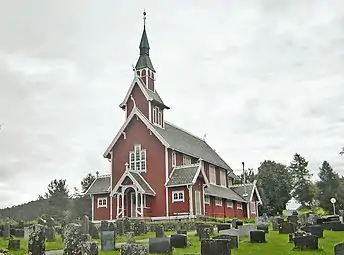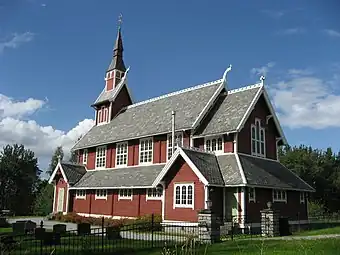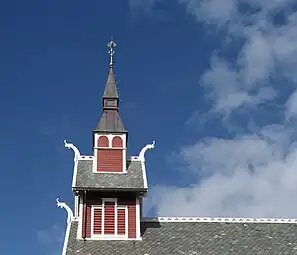| Veøy Church | |
|---|---|
| Veøy kyrkje | |
 View of the church | |
| 62°41′08″N 7°27′15″E / 62.685675632°N 7.4542719125°E | |
| Location | Molde Municipality, Møre og Romsdal |
| Country | Norway |
| Denomination | Church of Norway |
| Churchmanship | Evangelical Lutheran |
| History | |
| Status | Parish church |
| Founded | 1907 |
| Consecrated | 1907 |
| Architecture | |
| Functional status | Active |
| Architect(s) | Karl Norum |
| Architectural type | Long church |
| Style | Dragestil |
| Completed | 1907 |
| Specifications | |
| Capacity | 212 |
| Materials | Wood |
| Administration | |
| Diocese | Møre bispedømme |
| Deanery | Molde domprosti |
| Parish | Røvik og Veøy |
| Type | Church |
| Status | Listed |
| ID | 85828 |
Veøy Church (Norwegian: Veøy kyrkje) is a parish church of the Church of Norway in Molde Municipality in Møre og Romsdal county, Norway. It is located in the village of Sølsnes. It is the main church for the Røvik og Veøy parish which is part of the Molde domprosti (arch-deanery) in the Diocese of Møre. The red, wooden church was built in a long church design in the dragestil style in 1907 by the architect Karl Norum. The church seats about 212 people.[1][2]
History
Towards the end of the 19th century, the island of Veøya had long since been depopulated, with the exception of the clergy family and its household, so it was difficult to maintain a main parish church such as the Old Veøy Church on the island. In 1901, it was decided to take the island's medieval church out of use as a parish church and move the church site to Sølsnes on the mainland nearby. The new church was designed by the architect Karl Norum. The new building was completed and consecrated in 1907.[3][4]
Media gallery
 Front view
Front view Exterior from east
Exterior from east Close up of the tower
Close up of the tower Side view
Side view
See also
References
- ↑ "Veøy kyrkje, Sølsnes". Kirkesøk: Kirkebyggdatabasen. Retrieved 22 June 2019.
- ↑ "Oversikt over Nåværende Kirker" (in Norwegian). KirkeKonsulenten.no. Retrieved 22 June 2019.
- ↑ "Veøy kirke". Norges-Kirker.no (in Norwegian). Retrieved 20 July 2021.
- ↑ "Sølsnes (Veøy) kirkested" (in Norwegian). Norwegian Directorate for Cultural Heritage. Retrieved 20 July 2021.